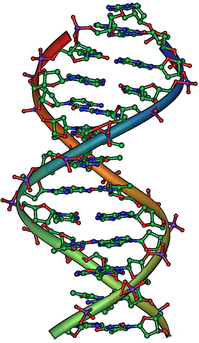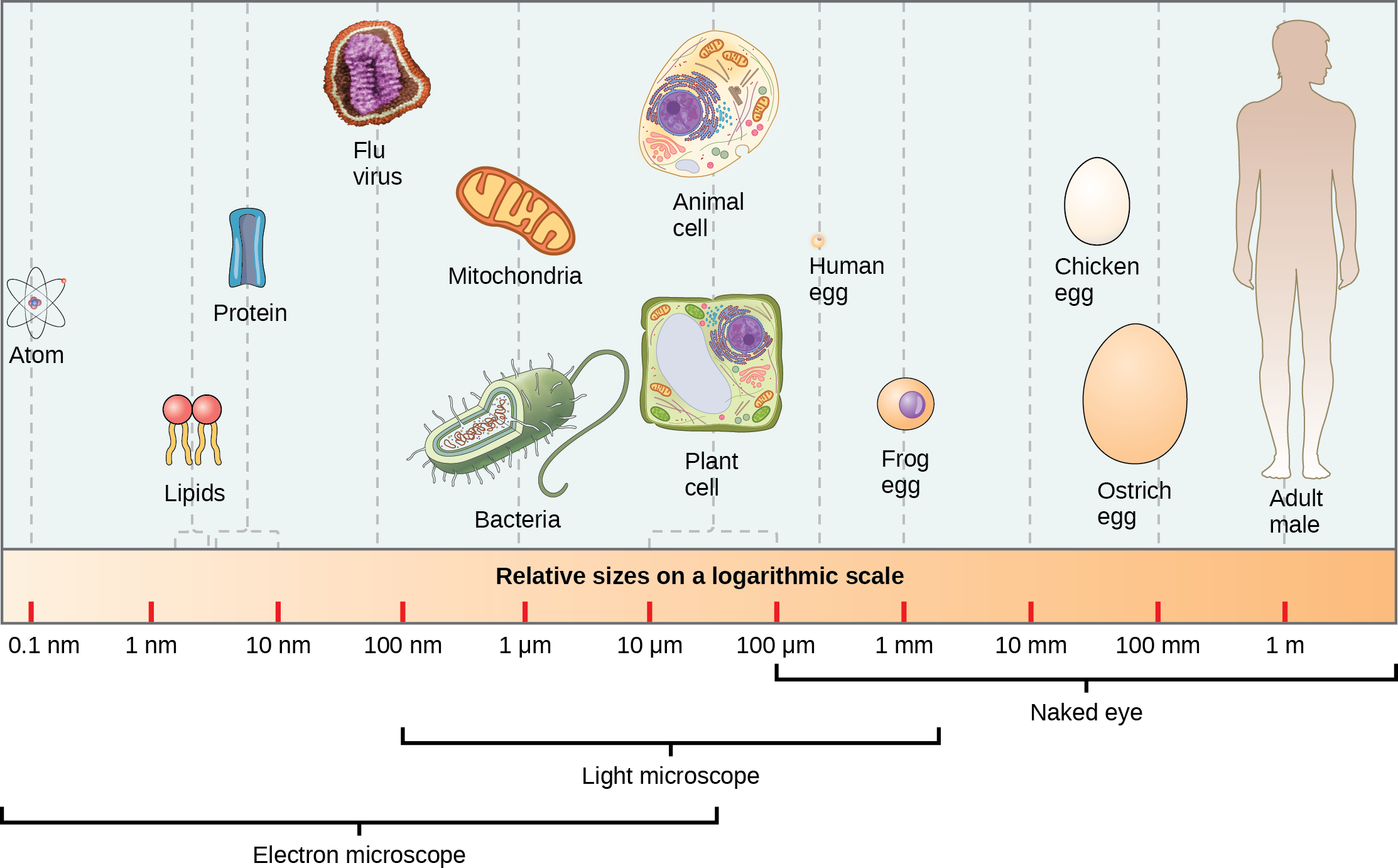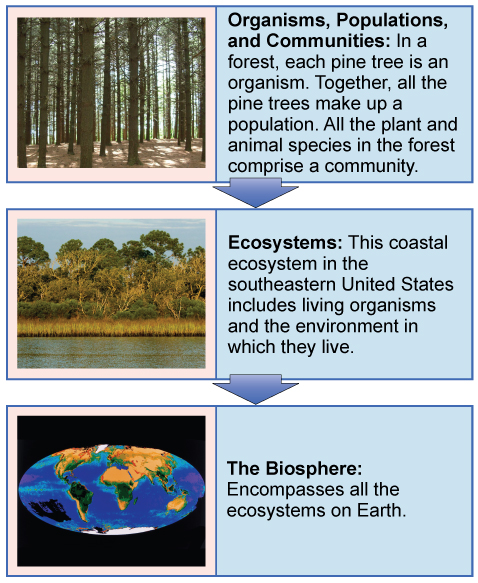1 1.2 The Scales of Life
Learning Objectives
- Organize biologically relevant elements (molecules, cells, tissues, organs, organisms….) by relative size.
- Describe how different levels of biology are connected.
Levels of organization of living things
Living things are highly organized and structured, following a hierarchy that we can examine on a scale from small to large. The atom is the smallest and most fundamental unit of matter that retains the properties omacromoleculesf an element. It consists of a nucleus surrounded by electrons. Atoms form molecules. A molecule is a chemical structure consisting of at least two atoms held together by one or more chemical bonds. Many molecules that are biologically important are macromolecules, large molecules that are typically formed by polymerization (a polymer is a large molecule that is made by combining smaller units called monomers, which are simpler than macromolecules). An example of a macromolecule is deoxyribonucleic acid (DNA) (Figure 1.2.1), which contains the instructions for the structure and functioning of all living organisms.

Some cells contain aggregates of macromolecules surrounded by membranes. We call these organelles. Organelles are small structures that exist within cells. Examples of organelles include mitochondria and chloroplasts, which carry out indispensable functions: mitochondria process energy to power the cell, while chloroplasts enable green plants to utilize the energy in sunlight to make sugars. All living things are made of cells. The cell itself is the smallest fundamental unit of structure and function in living organisms. Some organisms consist of a single cell and others are multicellular. Scientists classify cells as prokaryotic or eukaryotic. Prokaryotes are single-celled or colonial organisms that do not have membrane-bound nuclei. In contrast, the cells of eukaryotes do have membrane-bound organelles and a membrane-bound nucleus (Figure 1.2.2).

In larger organisms, cells combine to make tissues, which are groups of similar cells carrying out similar or related functions. Organs are collections of tissues grouped together performing a common function. Organs are present not only in animals but also in plants. An organ system is a higher level of organization that consists of functionally related organs. Mammals have many organ systems. For instance, the circulatory system transports blood through the body and to and from the lungs. It includes organs such as the heart and blood vessels. Organisms are individual living entities. For example, each tree in a forest is an organism. Single-celled prokaryotes and single-celled eukaryotes are also organisms, which biologists typically call microorganisms.
Biologists collectively call all the individuals of a species living within a specific area a population. For example, a forest may include many pine trees, which represent the population of pine trees in this forest. Different populations may live in the same specific area. For example, the forest with the pine trees includes populations of flowering plants, insects, and microbial populations. A community is the sum of populations inhabiting a particular area. For instance, all of the trees, flowers, insects, and other populations in a forest form the forest’s community. The forest itself is an ecosystem. An ecosystem consists of all the living things in a particular area together with the abiotic, nonliving parts of that environment such as nitrogen in the soil or rain water. At the highest level of organization, the biosphere is the collection of all ecosystems, and it represents the zones of life on Earth. It includes land, water, and even the atmosphere to a certain extent.

Practice Questions
Glossary
atom
the smallest and most fundamental unit of matter that retains the properties of an element. It consists of a nucleus surrounded by electrons
molecule
a chemical structure consisting of at least two atoms held together by one or more chemical bonds
organelle
aggregate of macromolecules surrounded by membranes with a particular function.
cell
the smallest fundamental unit of structure and function in living organisms
tissue
group of similar cells carrying out similar or related functions
organ
collection of tissues grouped together performing a common function
organism
individual living entity
population
all the individuals of a species living within a specific area
community
the sum of populations inhabiting a particular area
ecosystem
all the living things in a particular area together with the abiotic, nonliving parts of that environment
biosphere
the collection of all ecosystems, and it represents the zones of life on Earth
Figure Descriptions
Figure 1.2.1. The image depicts a 3D representation of a DNA double helix. The structure features two intertwined helical strands colored in shades of green, blue, and orange, illustrating the backbone of the DNA composed of sugar and phosphate groups. Between these strands are the base pairs, represented by red and blue lines connecting the opposing strands. The helical form twists symmetrically, demonstrating the classic double helix shape with consistent spacing between the turns. This structure gives an insight into the molecular organization of DNA. [Return to Figure 1.2.1]
Figure 1.2.2. The image illustrates the relative sizes of various biological and non-biological entities on a logarithmic scale. From left to right, the entities are an atom, protein, lipids, flu virus, mitochondrion, bacteria, animal cell, plant cell, human egg, frog egg, chicken egg, ostrich egg, and an adult male. Each entity is depicted graphically and aligned vertically with a corresponding marker on the scale bar at the bottom. The background features a grid with vertical dashed lines, indicating the incremental changes in scale. [Return to Figure 1.2.2]
Figure 1.2.3. The image is divided into three sections, each depicting a different ecological concept. The top section shows a dense forest with tall, closely spaced pine trees, with sunlight filtering through the trunks. The middle section features a coastal ecosystem with a body of water in the foreground and lush vegetation, including trees, in the background. The bottom section presents an image of the Earth, with its landmasses highlighted in green and brown and surrounded by blue water, symbolizing the biosphere. Each section has accompanying explanatory text:
Organisms, Populations, and Communities: In a forest, each pine tree is an organism. Together, all the pine trees make up a population. All the plant and animal species in the forest comprise a community.
Ecosystems: This coastal ecosystem in the southeastern United States includes living organisms and the environment in which they live.
The Biosphere: Encompasses all the ecosystems on Earth. [Return to Figure 1.2.3]
Licenses and Attributions
“1.2 The Scales of Life” is adapted from “1.2 Themes and Concepts of Biology” by Mary Ann Clark, Matthew Douglas, and Jung Choi for OpenStax Biology 2e under CC-BY 4.0. “1.2 The Scales of Life” is licensed under CC-BY-NC 4.0.
Media Attributions
- DNA © Andrew Z. Colvin is licensed under a CC BY-SA (Attribution ShareAlike) license
- 1A.B.5 Relative size of microbes © OpenStax Biology 2e is licensed under a CC BY (Attribution) license
- 1A.1.2Organisms to Ecosystems © OpenStax Biology 2e is licensed under a CC BY (Attribution) license
large, complex molecules built from organic building blocks (amino acids, nucleic acids, monosaccharides, fatty acids)
the smallest and most fundamental unit of matter that retains the properties of an element. It consists of a nucleus surrounded by electrons
a group of atoms bonded together, representing the smallest fundamental unit of a chemical compound that can take part in a chemical reaction.
aggregate of macromolecules surrounded by membranes
a eukaryotic cell organelle which carries out energy production in the form of ATP
the smallest fundamental unit of structure and function in living organisms.
groups of similar cells carrying out similar or related functions
individual living entity
all the individuals of a species living within a specific area
the sum of populations inhabiting a particular area
all the living things in a particular area together with the abiotic, nonliving parts of that environment
the collection of all ecosystems, and it represents the zones of life on Earth
